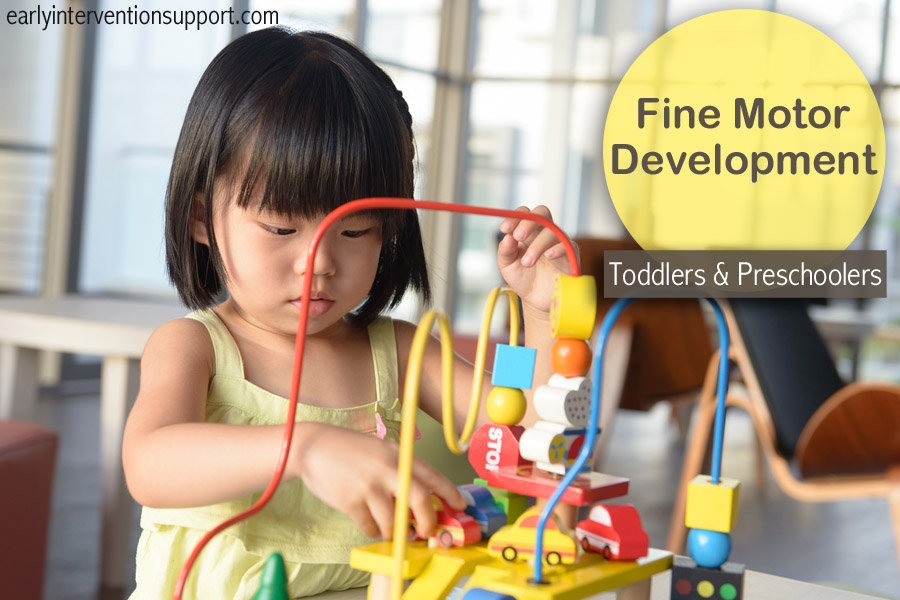During the first year of life, a child develops and gains new skills at an amazing rate. The infant goes from not having any voluntary control over his or her arms and hands to being able to grasp a small raisin with the thumb and index finger in a mature pincer grasp by his or her first birthday. But, fine motor skills do not stop developing after the first birthday. In fact, it is in the first two years of life that the foundation for skill development is laid.
It is helpful to think about fine motor development like the construction of a house. You have to have a good foundation to build upon. The foundation for fine motor development is: stability, bilateral coordination, and sensation.
Stability, Bilateral Coordination, and Sensation
Stability is a combination of strength and balance that allows one to keep one body part still while another part is moving. For example:
- The ability to push open a heavy door
- The ability to put on your pants without falling over
- The ability to carry a tray of drinks and not spill the drinks
- The ability to hold a camera still and take a picture
Bilateral coordination is the ability to efficiently use both hands together during an activity. For example:
- The ability to hold a bowl with one hand while using a spoon with the other hand
- The ability zip a zipper
- The ability hold the paper with one hand while cutting with scissors
- The ability to thread a needle
Sensation is the knowledge of where your fingers, hands, and arms are and what they are doing without constant, conscious attention to them. For example:
- The ability to pull a quarter out of a pocket full of change
- The ability to know where your hands need to be to catch a ball
- Timing when to kick a ball when playing soccer
- The ability to put your hair into a pony tail or braid
- The ability to know if your arm is overhead or at your side
Without this foundation a child will have difficulty building dexterity and ultimately have difficulty developing the skills to complete daily living activities including self-help skills or school readiness skills.
Fine Motor Skills Milestones
What does this look like in the older toddler and pre-school aged child? Listed below are fine motor milestones for ages 2-5 years of age. As you can see, without a good foundation, a child will struggle to meet his or her milestones successfully. This can ultimately impact a child’s performance once in school.
2-3 years of age:
- A child should have enough stability that he or she is able to reach away from their body without falling over
- They should be able to shift their weight from one side to another
- Hand dominance will not be established, but will begin to emerge.
- One hand will lead an activity with the other hand assisting (holding a jar and turning the lid to open or close the jar)
- Will hold a crayon/pencil with his or her whole hand and fingers pointing down
- Will demonstrate the ability to imitate simple lines (horizontal, vertical, and circle)
- By the age of 3, a child should be able to snip paper with scissors in one hand and the paper in the other hand
3-4 years of age:
- A child will show a strong preference for a dominant hand, but will continue to switch hands during activities.
- Will imitate a cross (+) and trace diamonds and triangles
- Will attempt to color in the lines with limited success
- By the 4th birthday a child should be holding a crayon/pencil with 3 fingers (held between the thumb and index finger and resting on the middle finger)
- When using scissors, should be able to move scissors forward and cut on a line and turn paper when cutting on a curve.
4-5 years of age:
- Hand preference should be strong and consistent; hand dominance is generally established between 4 and 6 years of age
- Will be able to stay inside the lines when coloring
- Will be able to copy more complex lines and shapes (diagonal lines, squares)
- When using scissors a child will start to make more precise cuts and be able to cut out a
Encourage Fine Motor Development with Play
To help build a good foundation for fine motor skill development, consider incorporating the following into your play with your child:
- Play with toys that come apart and fit back together
- Provide toys that have parts that go into holes (shape sorters or puzzles)
- Build with blocks
- Provide opportunities for play in water, sand, paint, etc.
- Introduce crayons, markers, etc. early (age 2) and encourage a child’s expression on paper
- Introduce safety scissors and let a child explore how they work and show the child how to hold and use the scissors
- Do pouring and dumping play in the bathtub or in the sandbox/water table
- Do action songs and rhymes together
- Encourage your child to help when getting dressed
- Encourage your child to feed themselves with and without utensils
By: Shelley Coleman Casto, MS, OTR/L
Resources:
Bruni, M. (2006). A model of hand skill development. In Fine motor skills for children with Down syndrome: A guide for parents and professionals (2nd ed., pp. 1-5). Bethesda, MD: Woodbine House.
Case-Smith, J., Allen, A., & Pratt, P. (1996). The Developmental Process. In Occupational Therapy for Children (Third ed., pp. 53 – 59). St. Louis: Mosby.
Fine motor skill development 0-6 years. (2002, January 1). Retrieved November 28, 2014, from http://www.skillbuildersonline.com/SBA/PDF/Fine_Motor_Skill_Development_0-6_Years.pdf

